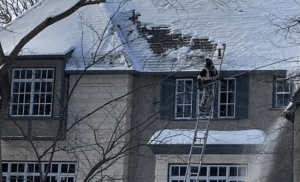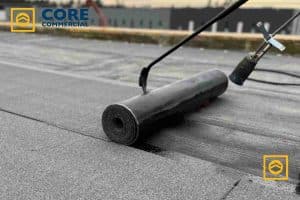Summer sun might feel great on your skin, but it’s rough on your roof. High heat, harsh UV rays, and pop-up storms can weaken your shingles, damage your flashing, and trap heat in your attic without warning. If you don’t catch these issues early, it can lead to roof leaks, expensive repairs, and energy bills that shoot through the roof literally.
One proven way to stay ahead of summer roof problems is by getting a mid-season roof inspection. It’s quick, affordable, and helps catch cracked sealants, heat blisters, or lifting shingles before they turn into costly leaks.
If you want to avoid emergency repairs, keep your home cooler, and make your roof last longer, this guide will walk you through everything you need to know about taking care of your roof during the summer months.

Table of Contents
Why Summer Roof Maintenance Matters
Most people think of roof problems happening during heavy rain or freezing winters. But heat damage in summer can be just as destructive—just slower and less obvious at first.
High temperatures cause roofing materials to expand, and when they cool at night, they contract. This constant movement can crack shingles, warp flashing, and break down seals. At the same time, UV radiation weakens shingles and dries out any exposed rubber or plastic parts.
Even more, if your attic doesn’t vent properly, the heat gets trapped inside your home. That added pressure from below shortens the life of your roofing system from both sides—top and bottom.
Ignoring summer maintenance might not show problems right away, but over time, you’ll start seeing things like:
- Curling or cracked shingles
- Leaky rooflines
- Loose flashing
- Peeling roof coatings
- Spikes in cooling bills
That’s why summer roofing care is just as important as checking your furnace in winter or cleaning gutters in fall.
Signs Your Roof Is Struggling in the Heat
Your roof won’t send you an alert when it’s under stress. But there are warning signs to look for before things get worse. Summer makes certain problems easier to spot, if you know what to watch.
Visual Clues from the Ground
- Shingle discoloration or fading: UV rays can bleach shingles, making your roof look old before its time.
- Cracked or curling shingles: Expansion and contraction cycles can split or warp the material.
- Moss or algae streaks: More common with trapped moisture under high temps.
- Sagging ridges or uneven areas: May signal deeper structural issues from heat exposure.
Interior Red Flags
- Hot or humid upstairs rooms: Poor attic ventilation or roof damage can trap heat inside.
- Water stains on ceilings: Indicates roof leaks that may have been triggered by thermal cracking.
- Mildew smell in attic: Could mean condensation isn’t escaping properly, often worsened by poor airflow.
If you spot any of these problems during summer, your roof might already be under stress—and it’s time to act before the damage gets worse.
How High Temperatures Affect Different Roofing Materials
Not all roofing systems respond to heat the same way. What’s minor for one roof type can be a serious issue for another. Here’s how common materials handle summer stress:
Asphalt Shingles
- Most affordable but ages quickly under strong UV exposure.
- Heat softens the asphalt, causing granule loss and curling edges.
- Vulnerable to blisters if moisture gets trapped beneath them.
Metal Roofs
- Reflect sunlight better but still expand in the heat.
- Fasteners can loosen over time with repeated expansion/contraction cycles.
- Good ventilation underneath is critical to prevent trapped heat.
Clay or Concrete Tiles
- Extremely durable but can crack under sudden temperature swings.
- Need strong underlayment and flashing to manage thermal shifts.
- Heavier weight can hide subtle shifting damage until it spreads.
Flat Roofing (TPO, EPDM, Modified Bitumen)
- UV rays can break down membrane surfaces without reflective coatings.
- Pooling water from summer storms can add extra heat stress.
- Seams and sealants often fail first from overheating.
Knowing your roof type helps you focus your care where it’s needed most.
Our Top Summer Roofing Care Tips
Whether your roof is brand new or over a decade old, summer care keeps it working better, longer. Here’s what you can do right now:
1. Schedule a Roof Inspection
Start the season with a professional check for cracks, soft spots, or early signs of trouble. A mid-summer inspection is just as useful—especially after a heatwave or storm.
2. Clean Debris and Branches
Remove leaves, twigs, or limbs that trap heat or block drainage. A clean roof stays cooler and dries faster after rain.
3. Check and Clear Gutters
Overflowing gutters cause water to back up under your roofline. Summer storms come fast, so make sure water can flow off your roof easily.
4. Trim Trees Around the Roof
Too much shade can trap moisture, and falling branches during summer storms are a common cause of roof punctures.
5. Ventilate the Attic
Make sure attic fans and vents are working. Good airflow cuts down on heat buildup and reduces pressure on your shingles from below.
6. Reapply Reflective Roof Coating (If Needed)
Especially for flat roofs or metal surfaces, reflective coatings reduce rooftop temperatures by dozens of degrees and extend the roof’s life.
Doing these tasks now can save you thousands in repairs later.
The Importance of Mid-Summer Roof Inspections
Summer can be long, and a lot can happen between June and September. That’s why we’re big believers in mid-summer inspections.
Here’s why they matter:
- Catch damage early: A windstorm or heatwave can cause fast-moving damage.
- Prevent mold: Inspections can spot attic condensation that leads to mold growth.
- Avoid big fall repairs: You’ll beat the seasonal rush by getting repairs done in summer.
- Keep your warranty valid: Some roof warranties require routine checkups, especially after extreme weather.
And the truth is, a quick inspection could mean the difference between a $200 sealant job now or a $6,000 re-roof later.
Heat-Reducing Roofing Upgrades to Consider
If your roof is older or struggling to stay cool, there are a few simple upgrades that can drastically improve its summer performance.
Radiant Barriers in the Attic
Reflects radiant heat toward the roof, keeping attic temps down. A cooler attic means less heat is transferred into your living space.
Solar-Powered Attic Fans
They kick on automatically during hot weather to pull heat out of the attic. This boosts airflow and protects roofing materials from below.
Light-Colored Shingles or Coatings
If you’re reroofing, consider light-colored materials. They reflect more sunlight and can lower roof temps by 20–30 degrees.
Upgraded Insulation
Newer insulation materials hold up better against high temperatures and help regulate indoor temps—saving you money on AC bills.
Common Summer Roofing Mistakes to Avoid
Some well-meaning homeowners accidentally make things worse by doing the wrong summer fixes. Here are the biggest ones to avoid:
- Walking on hot shingles: Foot traffic on softened shingles can leave permanent damage.
- Power washing the roof: This can strip off protective granules and weaken seals.
- Skipping attic checks: Many roof problems start inside, not outside.
- Patching without matching materials: Using the wrong sealant or flashing creates weak spots.
- Ignoring tiny leaks: Even small leaks grow faster in summer due to expansion.
It’s not just what you do, it’s how and when you do it.
Energy Savings From Summer Roof Care
Keeping your roof in good shape in summer doesn’t just prevent leaks—it helps lower your energy bills too. That’s a win-win.
Here’s how:
- Cooler attics mean less AC usage
- Reflective coatings bounce sunlight away from the home
- Proper ventilation prevents heat buildup inside the home
- Insulation stays dry and effective
Even small improvements can shave off 10%–30% on your cooling costs each month.
Over an entire summer, that can pay for the cost of a roof inspection and then some.
When to Call a Roofer for Help
Not all roofing issues can or should be handled DIY—especially in the heat. Call a professional roofer if you notice:
- Soft or sagging spots on the roof
- Large areas of missing shingles
- Water dripping during storms
- Stains growing on ceilings
- Persistent moldy smells in the attic
- Sudden spikes in your cooling bill with no other cause
Getting expert help early is the best way to avoid needing an emergency repair later.
Final Thoughts: Protecting Your Roof All Year Long
Taking care of your roof in summer is one of the smartest things you can do as a homeowner. The heat is tough on all roofing materials, and even the strongest roof can suffer in silence if you’re not looking for the signs.
A few simple steps, like a roof inspection, cleaning your gutters, improving ventilation, or applying reflective coatings, can make a huge difference in how well your roof handles the heat and how long it lasts.
If you want to protect your roofing investment, lower your energy bills, and avoid costly repairs, start your summer roofing care now, before the next heatwave rolls through.
FAQs
What are effective summer roof care tips?
Summer roof care tips include regular inspections, cleaning debris, checking gutters, improving attic ventilation, and applying reflective coatings. These steps help protect shingles from UV and heat damage, prevent leaks, and lower cooling energy costs. According to roofing experts, these simple seasonal tasks can significantly extend roof lifespan.






